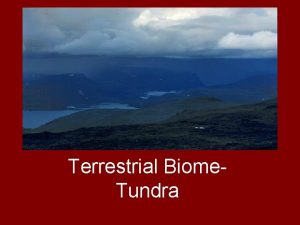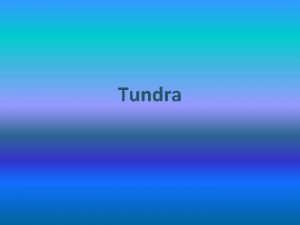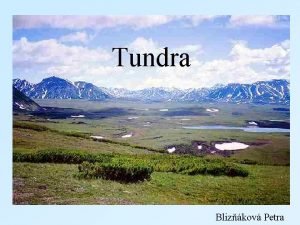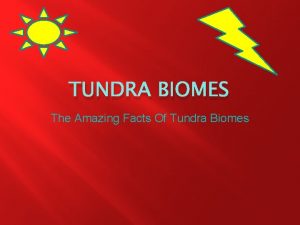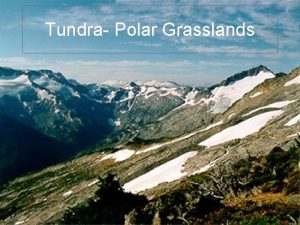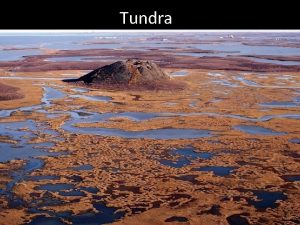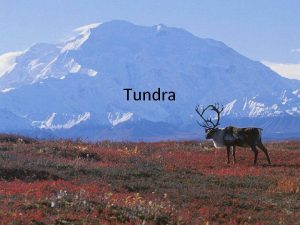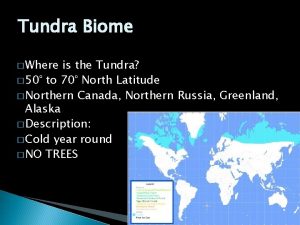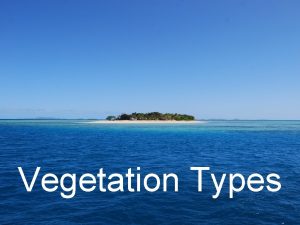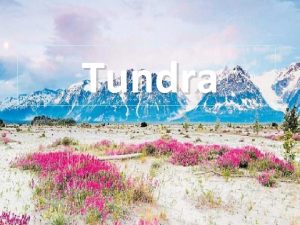Tundra Tundra The tundra is one of the





















- Slides: 21

Tundra

Tundra The tundra is one of the harshest habitats and it is the coldest! Temperatures in the tundra can reach as low as -25 degrees Fahrenheit! Beneath the tundra is permafrost. Permafrost is a permanently frozen layer of soil. There is very little rain or snow in the tundra, usually less than 15 inches a year. There are two types of tundra, the arctic and the alpine tundra. The arctic tundra is the land around the North Pole. The alpine tundra is found above the tree line of tall, cold mountains. Tundra covers 20% of the Earth's surface.

Tundra Summers are very short and cool, lasting only about 6 to 10 weeks and the winters are very long and very cold. In the winter, there is minimal daylight as the sun barely rises. Summer and winter are the Tundra's 2 main seasons.

Tundra - Plants grow close together, low to the ground are small. Many plants have a wax type of fuzzy, hairy coating on them which helps protect them from the cold and wind. This coating also helps them retain heat and moisture, and protects the plant seeds to for reproduction. Tundra means ‘treeless’, so most of the plants in the tundra are low growing plants. • Arctic Moss • Arctic Willow • Caribou Moss • Labrador Tea • Arctic Poppy • Cotton Grass • Lichens • Moss

Tundra – Plants & Adaptations Plants found here usually have small leaves, which helps the plants to retain moisture. Only the top layer of soil thaws out in the tundra, so the plants have very shallow root systems. Plants like lichens and moss can survive on bare rock with a bit of moisture. Most of the plants in the tundra are perennials and don’t die off in the winter. They have long life cycles to help with the short growing season.

Tundra – Animals & Adaptations Animals have many adaptations to survive in this harsh environment. Animals need shelter and insulation in the tundra. The animals here have thicker and warmer feathers and fur. Many of them have larger bodies and shorter arms, legs and tails which helps them retain their heat better and prevent heat loss. Many of the birds of the tundra have two coats of feathers to help keep them warm.

Tundra – Animals & Adaptations Many animals of the tundra have feet that are lined with fur to help keep them warm. Some of the animals of the tundra (bears, marmot, arctic squirrels) will hibernate for the winter and others will burrow (lemmings, ermine). Many of the insects will spend their entire life buried in the soil, rocks or plants which acts as a shelter for them.




Ocean

Ocean The oceans hold about 96. 5% of all of Earth’s water. Around 70% of the Earth’s surface is covered by 5 oceans. The largest ocean on Earth is the Pacific Ocean, covering around 30% of the Earth’s surface. The longest mountain range in the world is found under water. Stretching over 56, 000 km, the Mid-Oceanic Ridge is a mountain chain that runs along the center of the ocean basins.

Ocean The sea is home to the world’s largest living structure – the Great Barrier Reef. Measuring around 2, 600 km, it can even be seen from the Moon! We have only explored about 5% of the world’s oceans.

Ocean - Plants Most of the ocean's plant life consists of microscopic algae called phytoplankton that float at the surface. Seaweed and kelp are big algae easily visible to the naked eye. Marine plants with roots, like seagrasses, can only survive as deep as the sun’s rays can support photosynthesis.

Ocean – Plants & Adaptations Ocean plants have adapted to the salt by breaking down salt into chlorine and sodium ions. Some plants store the salt and later get rid of it in the air. Marine plants and algae attach firmly to rocks and other things, so waves don't wash them away. Certain seaweeds are tough and leathery, this protects them from being torn or dried out by the sun.

Ocean Animals Tube worms, clams, and mussels gather around vents to feed on heat-loving bacteria. Bizarre fish with sensitive eyes, translucent fangs, and bioluminescent lures lurk about in deep waters. Other fish, octopuses, squid, eels, dolphins, and whales swim through the open waters while crabs, lobsters, starfish, oysters, and snails crawl and scoot along the ocean bottom. Creatures like jellyfish can’t get around well on their own and rely on wind and currents. Mammals like otters, walruses, and even polar bears also depend on the ocean for their survival and dip in and out as they need to.

Ocean – Animals & Adaptations There are 120 species of mammals including whales, dolphins, porpoises, seals and sea lions which have evolved to adapt to their aquatic environment by developing small appendages (ears and flippers), a generally large size, sleek body shapes and different methods to cope with extreme changes in temperature. Fish can drink saltwater and eliminate the salt through their gills. Crocodiles living in saltwater have adapted by developing special glands in their tongues to help them excrete salt.




 One god one empire one religion
One god one empire one religion One ford behaviors
One ford behaviors Studiendekanat uni bonn
Studiendekanat uni bonn One one one little puppy run
One one one little puppy run See one do one teach one
See one do one teach one Asean tourism strategic plan
Asean tourism strategic plan One king one law one faith
One king one law one faith See one, do one, teach one
See one, do one, teach one One vision one identity one community
One vision one identity one community One empire one god one emperor
One empire one god one emperor One face one voice one habit and two persons
One face one voice one habit and two persons Thế nào là hệ số cao nhất
Thế nào là hệ số cao nhất Tư thế ngồi viết
Tư thế ngồi viết Sự nuôi và dạy con của hổ
Sự nuôi và dạy con của hổ Hình ảnh bộ gõ cơ thể búng tay
Hình ảnh bộ gõ cơ thể búng tay đặc điểm cơ thể của người tối cổ
đặc điểm cơ thể của người tối cổ Mật thư anh em như thể tay chân
Mật thư anh em như thể tay chân Thang điểm glasgow
Thang điểm glasgow Tư thế ngồi viết
Tư thế ngồi viết Thế nào là mạng điện lắp đặt kiểu nổi
Thế nào là mạng điện lắp đặt kiểu nổi Thẻ vin
Thẻ vin Thể thơ truyền thống
Thể thơ truyền thống

























